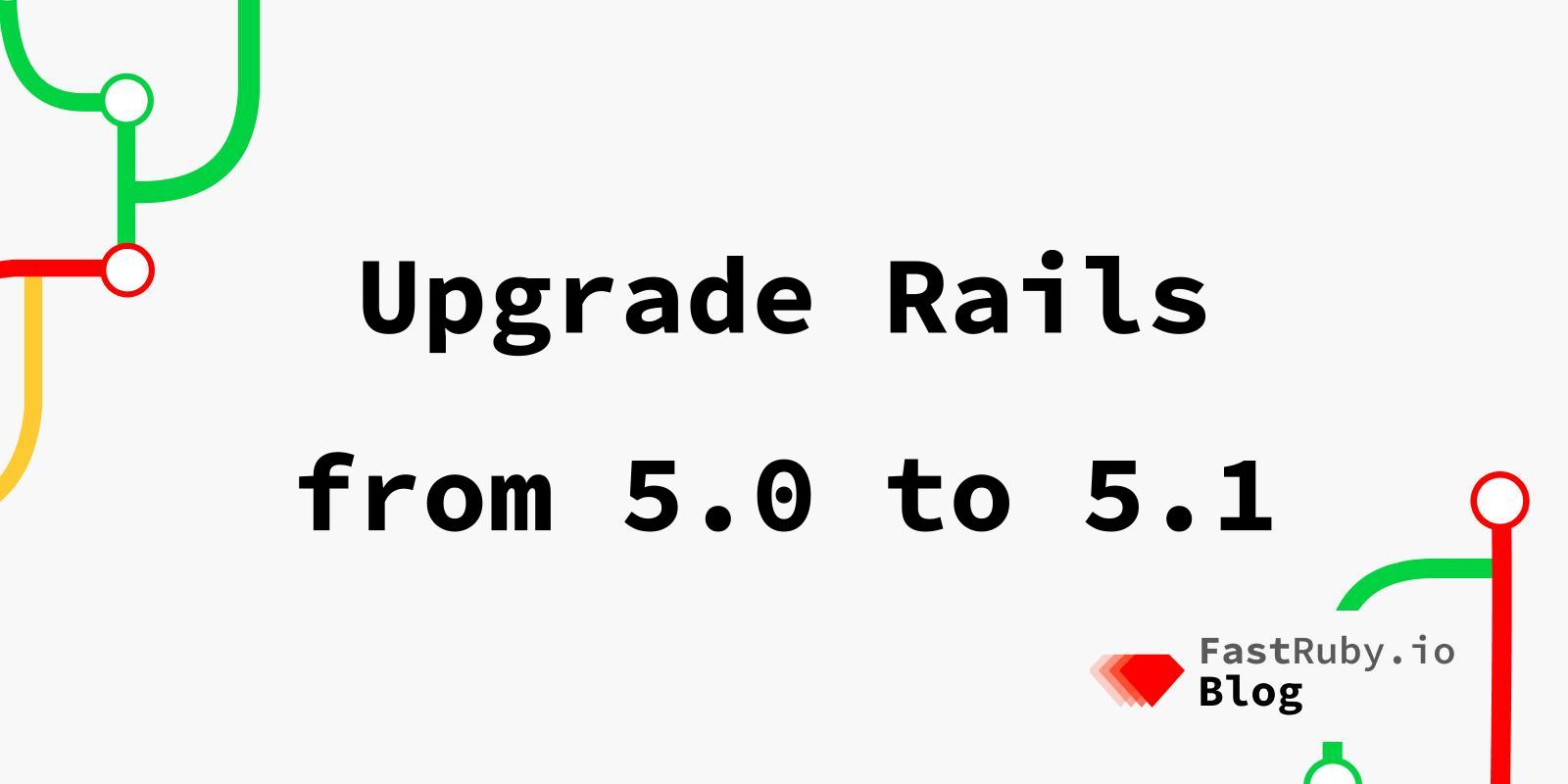
Upgrade Rails from 5.0 to 5.1
This article is part of our Upgrade Rails series. To see more of them, click here .
This article will cover the most important aspects that you need to know to get your Ruby on Rails application from version 5.0 to 5.1 .
- Preparations
- Ruby version
- Gems
- Config files
- Application code
- ActiveRecord
- Controllers
- Testing
- Next steps
1. Preparations
Before beginning with the upgrade process, we have some recommended preparations:
- Your Rails app should have the latest patch version before you move to the next major/minor version.
- You should have at least 80% test coverage unless you have a dedicated QA team.
- Follow a Git flow workflow to actively manage at least two environments: staging and production.
- Check your Gemfile.lock for incompatibilities by using RailsBump .
- Create a dual boot mechanism, the fastest way to do this is installing the handy gem next_rails .
For full details check out our article on How to Prepare Your App for a Rails Upgrade .
2. Ruby version
Like Rails 5.0, Rails 5.1 requires Ruby 2.2.2 or later.
If you want to know more about the Ruby versions that you could use, check out our Ruby & Rails Compatibility Table .
3. Gems
Make sure the gems you use are compatible with Rails 5.1, you can check this using RailsBump .
If you can’t find the gem in RailsBump, you could try using next_rails to
find incompatibilities in your dependencies:
gem install next_rails
bundle_report compatibility --rails-version=5.1.0
If that does not work, you’ll need to manually check the GitHub page for the project to find out its status. In case you own the gem, you’ll need to make sure it supports Rails 5.1 and if it doesn’t, update it.
4. Config files
Rails includes the rails app:update task .
You can use this task as a guideline as explained thoroughly in
this post .
You might run into an error trying to run that command:
$ bundle exec rails app:update
rails aborted!
LoadError: cannot load such file -- rails/commands/server
/Users/etagwerker/.rvm/gems/ruby-2.4.9@ombu/gems/bootsnap-1.4.8/lib/bootsnap/load_path_cache/core_ext/kernel_require.rb:34:in `require'
/Users/etagwerker/.rvm/gems/ruby-2.4.9@ombu/gems/activesupport-5.1.7/lib/active_support/dependencies.rb:292:in `block in require'
/Users/etagwerker/.rvm/gems/ruby-2.4.9@ombu/gems/activesupport-5.1.7/lib/active_support/dependencies.rb:258:in `load_dependency'
/Users/etagwerker/.rvm/gems/ruby-2.4.9@ombu/gems/activesupport-5.1.7/lib/active_support/dependencies.rb:292:in `require'
/Users/etagwerker/Projects/ombulabs/ombushop/config/application.rb:5:in `<main>'
If that is the case, you will need to change this require statement:
require 'rails/commands/server'
To:
require 'rails/commands/server/server_command'
As an alternative, check out RailsDiff , which provides an overview of the changes in a basic Rails app between 5.0.x and 5.1.x (or any other source/target versions). Always target your upgrade to the latest patch version (e.g: 5.1.6 instead of 5.1.0).
Some assets configuration changes you’ll have to do on your
config/environments/{development, test, production}.rb files are:
Before:
config.serve_static_files = false
config.static_cache_control = "public, max-age=3600"
After:
config.public_file_server.enabled = false
config.public_file_server.headers = {
'Cache-Control' => "public, max-age=3600"
}
5. Application code
5.1. ActiveRecord
-
The
raise_in_transactional_callbacksoption is now removed. It was already deprecated and covered in a previous upgrade . -
Also removed was
use_transactional_fixtures, which was replaced byuse_transactional_tests. -
ActiveRecord::Base#uniqwas removed, it was deprecated in Rails 5.0 and has been replaced by#distinct. Check out https://github.com/rails/rails/pull/20198 for the discussion. -
The ordering of association statements is now significant. In particular, you can no longer declare a
has_many :throughassociation before declaring the association that implements thethrough. You must declare the joined model first.
This will no longer work:
has_many :posts, :through => :authors
has_many :authors
Change To:
has_many :authors
has_many :posts, :through => :authors
- If you are using a
before_destroycallback, you now must explicitly throw:abort
Previously, a before_destroy callback could return false to abort the operation
but now rails requires you to throw :abort to stop the operation
5.2. Controllers
- Before Rails 5.1, conditions in filters could be invoked using strings. They now have to be symbols:
Before
before_action :authenticate_user!, unless: 'has_project_guest_id'
After:
before_action :authenticate_user!, unless: :has_project_guest_id
- All
*_filtermethods are now called*_action:
These methods were actually already deprecated in Rails 5.0, and Rails 5.1
removes support for *_filter usage, so you should be using *_action.
Before:
skip_before_filter :authenticate_user!
before_filter :authenticate_user!
after_filter :do_something
After:
skip_before_action :authenticate_user!
before_action :authenticate_user!
after_action :do_something
- render no longer supports :text and :nothing arguments.
Instead of :text you now have to use :plain. And in cases where the controller
renders :nothing, you should now use the head method to send a bodyless response.
example: head :ok will answer the request with a 200 response, without a body.
- additionally render also no longer accepts
nothing: true.
Using head :ok is an effective alternative and so is body: nil.
6. Testing
- Parameters in controller tests now need a
paramskey:
Rails 5.0 had already deprecated this behavior, and Rails 5.1 drops support for passing parameters without using keyword arguments. This change is necessary even if you’re using RSpec:
Before:
expect { post :create, params }.to change(Project, :count).by(1)
After:
expect { post :create, params: params }.to change(Project, :count).by(1)
7. Next steps
If you successfully followed all of these steps, you should now be running Rails 5.1! Do you have any other useful tips or recommendations? Share them with us in the comments section.
If you’re not on Rails 5.1 yet, we can help! Download our free eBook: The Complete Guide to Upgrade Rails .